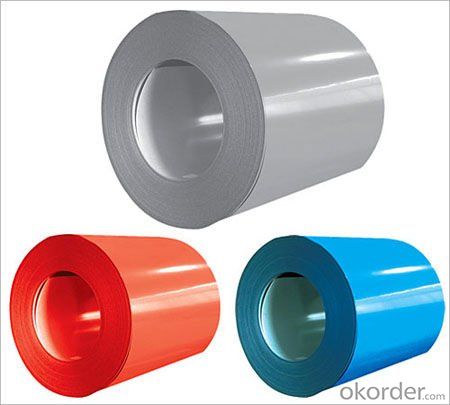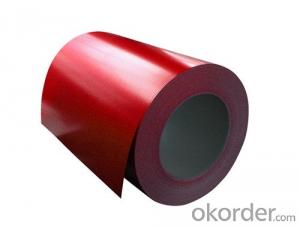Pre-painted Galvanized/Aluzinc Steel Sheet Coil with Prime Quality and Lowest Price Red
- Loading Port:
- Shanghai
- Payment Terms:
- TT OR LC
- Min Order Qty:
- 100 m.t.
- Supply Capability:
- 10000 m.t./month
OKorder Service Pledge
OKorder Financial Service
You Might Also Like
1. Pre-Painted Galvanized/Aluzinc Steel Coil Description:
With GI as base material, after pretreatment good capable of decoration, molding, corrosion resistance. It generally displays superior workability, durability and weather resistance.
2.Main Features of the Pre-Painted Galvanized/Aluzinc Steel Coil:
• Excellent process capability
• Smooth and flat surface
• Workability, durability
• Good visual effect
3.Pre-Painted Galvanized/Aluzinc Steel Coil Images

4.Pre-Painted Galvanized/Aluzinc Steel Coil Specification
Standard: AISI, ASTM, BS, DIN, GB, JIS
Grade: DX51D, DX52D
Thickness: 0.17-2.0mm
Application: Boiler Plate
Special Use: High-strength Steel Plate
Width: 20-1250mm
Length: customized
commoidty: pre-painted galvanized steel coil
Thickness: 0.13-4.0mm
width: 20-1250mm
zinc coating: 40-180g/m2
printing thickness: top side: 20+/-5 microns, back side: 5-7 microns
color: RED color
surface treatment: color coated
coil weight: 4-7 tons
coil ID: 508/610mm
packaging: standard seaworthy packing
5.FAQ of Pre-Painted Galvanized/Aluzinc Steel Coil
1. What’s the application of this product?
Usually within thirty working days after receiving buyer’s advance payment or LC.usually takes 15-25 days, but the shipment will depend on the vessel situation.
- Q:What are the different types of steel processing equipment for coils?
- There are several types of steel processing equipment for coils, including slitters, cut-to-length lines, leveling machines, coil cars, and stackers. Slitters are used to cut wide coils into narrower strips, while cut-to-length lines can cut coils into specific lengths. Leveling machines are used to flatten and remove any imperfections on the surface of the coils. Coil cars are used to transport the coils within the processing facility, and stackers are used to neatly stack the coils for storage or transportation.
- Q:What are the common packaging methods for steel coils?
- The common packaging methods for steel coils often involve using steel strapping or plastic banding to secure the coils, followed by either placing them on wooden pallets or loading them into steel crates for transportation and storage. Additionally, protective materials such as cardboard or stretch film may be used to prevent damage and ensure the integrity of the coils during shipping.
- Q:How are steel coils used in the manufacturing of lighting fixtures?
- Steel coils are commonly used in the manufacturing of lighting fixtures as they provide a sturdy and durable framework for the fixtures. The coils are often shaped and welded to create the desired structure, ensuring that the lighting fixtures are robust and can withstand various installation environments. Additionally, steel coils can be coated or painted to enhance the aesthetics of the fixtures, making them more visually appealing.
- Q:tinplate,hot rolled coil,hot rolled sheet,cold rolled coil,cold rolled sheet,d bar,wire rod,triangle,structural steel,steel pipe,steel tube,carbon steel pipe
- Here are the top 30 steel producing companies in the world, listed by the megaton output: 1. 63.0 Mton Mittal Steel Company NV (Global) [2] 2. 46.7 Mton Arcelor (Europe) [3] 3. 32.0 Mton Nippon Steel (Japan) [4] 4. 30.5 Mton POSCO (South Korea) [5] 5. 29.9 Mton JFE (Japan) [6] 6. 23.8 Mton Shanghai Baosteel Group Corporation (China) 7. 19.3 Mton United States Steel Corporation (United States) 8. 18.4 Mton Nucor Corporation (United States) 9. 18.2 Mton Corus Group (Europe) [7] 10. 17.5 Mton Riva Group (Europe) [8] 11. 16.5 Mton ThyssenKrupp (Europe) [9] 12. 16.1 Mton Tangshan (China) 13. 13.9 Mton EvrazHolding (Russia) 14. 13.7 Mton Gerdau (Brazil) 15. 13.6 Mton Severstal (Russia) 16. 13.5 Mton Sumitomo Metal Industries (Japan) 17. 13.4 Mton SAIL (India) 18. 12.0 Mton Wuhan Iron and Steel (China) 19. 11.9 Mton Anshan (China) 20. 11.4 Mton Magnitogorsk (Russia) 21. 10.5 Mton Jiangsu Shagang (China) 22. 10.5 Mton Shougang (China) 23. 10.4 Mton Jinan (China) 24. 10.3 Mton Laiwu (China) 25. 10.3 Mton China Steel (Taiwan) [10] 26. 9.6 Mton Maanshan 27. 9.4 Mton Imidro 28. 8.7 Mton Techint 29. 8.7 Mton Usiminas (Brazil) 30. 8.5 Mton Novolipetsk (Russia)
- Q:I have been thinking of buying a knife that says it has damascus steel. The reason for the question is that many people told me that damascus steel does not exist anymore, and that damascus nowadays is fake. Is this true???
- damascus steel it says is made from ore containing either tungsten or vanadium, although most tools I've seen are made from chrome vanadium, it wouldn't be hard in this day and age to get the proper material. Although it DOES say in wikipedia that apparently the technique died out a long time ago due to shortage of the ore. Then it talks about reproduction attempts. So theoretically, yes, it could be the deal deal. But it does refer at the bottom about damascend steel which is made with a different technique, you could be buying one of those. NEXT TIME JUST LOOK UP THE ARTICLE YOURSELF AND READ IT
- Q:I'm a big fan of stainless steel and sterling silver, but not of the humidity of the country I'm in. Therefore I sweat more. Gross, I know. I'm buying a necklace chain for my ring.So does sweat contribute to tarnishing of silver and steel? The real kind?
- steel shouldn't really tarnish, it rusts and moisture increases that. Silver tarnishes when exposed to air and sulfur. Moisture increases the process a bit, but it happens anyway. Sweat is not gross, it's a necessary function of your body, otherwise you would die. A lot of sports people wear jewelry and they sweat a lot. If you wear the jewelry all the time, that will prevent the tarnish a bit. If you take it off, clean it (water and dish washing liquid), dry it and put it in a zip lock back to keep it away from air and moisture. In the end, cleaning the jewelry is quick and easy so don't worry about it.
- Q:I am a beginner (never played before!) and I am going to try to teach myself since I think it is a lovely instrument. I am fourteen-years-old so I am not 'adult-size', haha. Anyway, what is difference between nylon strings and steel strings?Thanks :)
- Small guitars easier to find in classical range. I assume their must be small steel strings but not seen them.
- Q:What are the different methods of perforating steel coils?
- Various techniques are employed to perforate steel coils, each possessing unique merits and applications. 1. Mechanical Punching: One frequently employed method for perforating steel coils is mechanical punching. This involves utilizing a mechanical press, punch, and die set to puncture holes in the coil. Customization of hole size and shape is achievable by designing the punch and die set accordingly. Mechanical punching is efficient and generates consistent results, producing high-quality holes. 2. Laser Cutting: For intricate designs or complex hole patterns, laser cutting is a sought-after technique to perforate steel coils. A powerful laser beam is employed to precisely and cleanly cut through the coil, creating holes. Hole size, shape, and spacing flexibility are offered by laser cutting, which can be computer-controlled for precise and repeatable outcomes. 3. CNC Plasma Cutting: This method leverages a high-velocity plasma jet to cut through the steel coil and create perforations. CNC technology guides the plasma cutter, ensuring precise and accurate hole patterns. CNC plasma cutting is ideal for thicker steel coils and can generate larger holes compared to laser cutting. 4. Waterjet Cutting: The use of a high-pressure jet of water mixed with an abrasive substance characterizes waterjet cutting for perforating steel coils. This technique allows versatility in terms of hole dimensions, shapes, and compatibility with different materials. Waterjet cutting is renowned for its capability to produce intricate and precise perforations without causing heat-affected zones or distortion. 5. Electrical Discharge Machining (EDM): EDM is an approach that employs electrical discharges to erode the material, forming perforations in the steel coil. It involves the use of a conductive electrode and dielectric fluid to generate controlled sparks, removing material and creating holes. EDM is suitable for creating complex shapes and patterns, particularly on hard materials. The choice of method depends on various factors, including desired hole size and shape, steel coil thickness and type, required precision, and production volume. Each method has its own strengths and limitations, necessitating the selection of the most appropriate technique based on the specific requirements of the perforated steel coils.
- Q:How are steel coils used in the production of pipelines?
- Steel coils are an essential component in the production of pipelines. These coils, made from high-quality steel, are used to manufacture the pipes themselves. The process begins by unrolling the steel coil and cutting it into the desired size and length. The cut pieces are then shaped into cylindrical tubes using a process called pipe forming. Once the pipes are formed, they undergo various additional processes to enhance their strength and durability. This may include welding, heat treatment, and coating to protect against corrosion. Steel coils are also used to create the necessary fittings and connectors that are essential for connecting and joining the pipes together. The use of steel coils in pipeline production offers several advantages. Firstly, steel is a strong and durable material, making it ideal for handling the high pressure and stress that pipelines endure. Additionally, steel is resistant to corrosion, which is crucial for pipelines that transport various substances such as oil, gas, or water. Furthermore, steel coils allow for efficient production processes. The uniformity of the coils ensures consistent pipe dimensions, resulting in easy assembly and installation. The versatility of steel also allows for customization, enabling manufacturers to produce pipes of various sizes and specifications to meet specific project requirements. In conclusion, steel coils play a vital role in the production of pipelines. They are used to create the pipes themselves, as well as the necessary fittings and connectors. The use of steel ensures strength, durability, and corrosion resistance, making it the preferred material for pipelines. Moreover, steel coils enable efficient production processes and offer versatility in terms of customization.
- Q:Can steel coils be coated with thermally insulating materials?
- Yes, steel coils can be coated with thermally insulating materials.
1. Manufacturer Overview |
|
|---|---|
| Location | |
| Year Established | |
| Annual Output Value | |
| Main Markets | |
| Company Certifications | |
2. Manufacturer Certificates |
|
|---|---|
| a) Certification Name | |
| Range | |
| Reference | |
| Validity Period | |
3. Manufacturer Capability |
|
|---|---|
| a)Trade Capacity | |
| Nearest Port | |
| Export Percentage | |
| No.of Employees in Trade Department | |
| Language Spoken: | |
| b)Factory Information | |
| Factory Size: | |
| No. of Production Lines | |
| Contract Manufacturing | |
| Product Price Range | |
Send your message to us
Pre-painted Galvanized/Aluzinc Steel Sheet Coil with Prime Quality and Lowest Price Red
- Loading Port:
- Shanghai
- Payment Terms:
- TT OR LC
- Min Order Qty:
- 100 m.t.
- Supply Capability:
- 10000 m.t./month
OKorder Service Pledge
OKorder Financial Service
Similar products
New products
Hot products
Related keywords





























